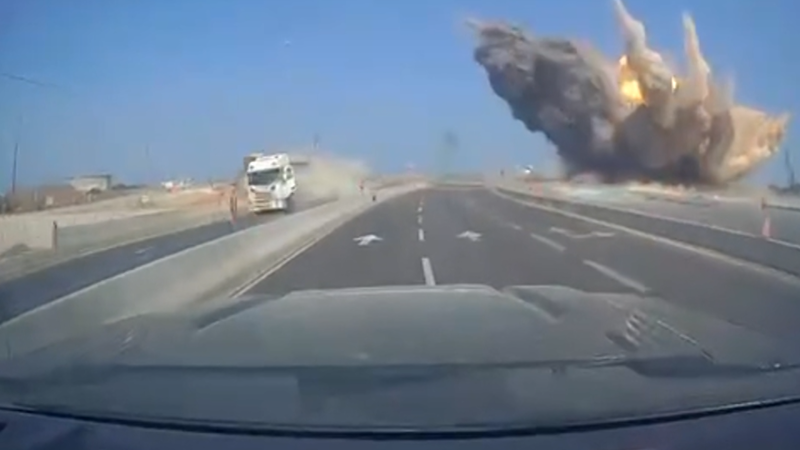In a stark reminder of the escalating tensions in the Middle East, dashcam footage that has rapidly circulated across various social media platforms captures the harrowing moment when an Iranian airstrike struck near the Israeli city of Ashdod. The disturbing visuals not only depict the immediate chaos and destruction wrought by the attack but also serve as a powerful symbol of the ongoing conflict that has gripped the region for decades. As the footage spread, reactions emerged from various corners of the globe, reflecting a mix of fear, outrage, and calls for dialogue. This incident marks a significant escalation in hostilities, with potential ramifications that extend far beyond the immediate geographical area.
The Israeli national emergency service, Magen David Adom (MDA), has been on high alert since the attack, dispatching emergency crews to multiple reported impact sites across the country. Their swift response highlights the urgency of the situation, as they work to assess the damage and provide assistance to those affected. Eyewitness accounts from Ashdod paint a grim picture: panic ensued as residents heard the deafening roar of missiles slicing through the sky, followed by the resounding explosions that shook buildings and rattled nerves. Local hospitals braced for an influx of casualties, while authorities scrambled to secure the area against further attacks.
As the dust settled in Ashdod, analysts began to dissect the motivations behind this latest Iranian strike. Iran has continually positioned itself as a formidable player in the regional power dynamics, often engaging in aggressive tactics to assert its influence. The missile barrage appears to be a continuation of Iran’s broader strategy to challenge Israeli security and demonstrate its military capabilities. Experts suggest that this incident is not merely a random act of aggression but rather a calculated move designed to send a message to both Israel and its allies, particularly the United States, regarding Tehran’s resolve in the face of perceived threats.
This incident also raises troubling questions about the effectiveness of existing diplomatic efforts aimed at mitigating tensions in the region. For years, various international players have sought to broker peace between Israel and its neighbors, yet the cycle of violence continues unabated. The Iranian strike serves as a stark reminder of the fragility of these diplomatic overtures, illustrating how quickly a situation can escalate from political rhetoric to armed conflict. The geopolitical landscape is further complicated by the involvement of various non-state actors and other nations, each with their own agendas and interests in the region.
The implications of this attack could reverberate well beyond Ashdod, as military analysts speculate on the likelihood of retaliatory measures from Israel. Historically, Israel has responded decisively to such provocations, often launching retaliatory strikes aimed at Iranian military assets in Syria and elsewhere. This tit-for-tat dynamic raises the prospect of a broader conflict, one that could potentially draw in other regional powers and further destabilize an already volatile area. The reality of such a scenario is more than a theoretical concern; it is a potential crisis that could affect millions.
Moreover, the incident has further polarized public opinion, both within Israel and internationally. Social media platforms have become battlegrounds for narratives, with supporters and opponents of various factions voicing their opinions. Some express solidarity with Israel’s right to defend itself, while others condemn the cycle of violence and call for diplomatic solutions. Such discussions underscore the deep divisions that exist, not only between nations but also within communities, as individuals grapple with the complexities of loyalty, security, and morality in times of conflict.
In the aftermath of the attack, Israeli officials have reiterated their commitment to national security, emphasizing the importance of readiness in the face of external threats. Prime Minister Naftali Bennett, in addressing the nation, affirmed that Israel would take all necessary measures to protect its citizens from further harm. His statements were met with a mix of support and skepticism, as citizens weighed the government’s response against the backdrop of ongoing hostilities. Many are left questioning what the future holds for Israel, as well as the broader implications for peace in the Middle East.
As global leaders monitor the situation closely, conversations regarding military aid and strategic alliances have intensified. The United States, a longstanding ally of Israel, has reiterated its support, yet the complexities of international relations mean that any response must be carefully calculated to avoid exacerbating tensions. The challenge lies in balancing military assistance with diplomatic efforts aimed at de-escalation. In recent years, the Biden administration has sought to navigate these murky waters, grappling with the dual imperatives of supporting an ally while striving to foster dialogue with Iran.
Experts emphasize that the broader implications of this strike are significant, not just for Israel and Iran, but for the entire region. The potential for an expanded conflict cannot be overlooked, as the actions taken in the coming days and weeks will set a precedent for future interactions between these nations. The stakes are high, with the possibility of drawing in neighboring countries, each with their own vested interests and historical grievances. As the situation continues to unfold, the international community watches closely, aware that the consequences of this attack could have far-reaching effects on global stability.
In the wake of this tumultuous episode, the human cost of conflict remains a sobering reality. Families in Ashdod are left to pick up the pieces, facing not only the physical destruction of their homes but also the psychological toll that such violence inflicts. The resilience of these communities is tested, as they strive to maintain a sense of normalcy amid chaos. Local organizations are mobilizing to provide support, offering counseling and resources to those affected by the trauma of the attack.
As news of the Iranian strike continues to reverberate around the world, the question remains: what will it take to break the cycle of violence and pave the way for lasting peace? The complexities of the Middle East conflict cannot be overstated, yet there exists a collective yearning for a resolution that transcends borders and ideologies. The hope is that, in the face of adversity, there will emerge a renewed commitment to dialogue and understanding, fostering a future where such acts of aggression become relics of the past. Until then, the world watches and waits, aware that the actions taken today will shape the narrative of tomorrow, in a region where the stakes have never been higher.
Continue reading the complete article on the original source



